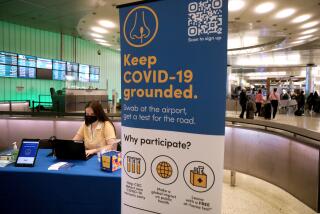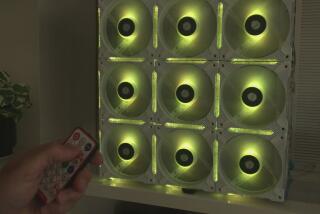‘Apollo 13 moments’: Amid coronavirus crisis, doctors, inventors convert devices into ventilators
- Share via
WASHINGTON — Dr. Charles Powell describes it as an “Apollo 13 moment.” In just a few days, a team of doctors and respiratory therapists at Mount Sinai Hospital in New York City scavenged tubes and electronics, crafted a key part on a 3-D printer, and successfully converted a $1,500 sleep therapy device into a full-blown ventilator, capable of substituting for the $50,000 machine on many, although not all, patients.
Across the country, Isaac Larian, a Los Angeles entrepreneur and owner of one of the country’s largest toy manufacturing companies, pursued a similar goal. His designers and engineers worked with doctors at Ronald Reagan UCLA Medical Center to create two types of masks resembling those used by scuba divers — one to protect healthcare workers and the other to assist patients with breathing problems.
“Apollo 13” efforts, a reference to NASA’s daring rescue of a damaged spacecraft heading to the moon in 1970, are taking place around the country as doctors, researchers and entrepreneurs confront the nation’s shortages of critical medical supplies and turn their ingenuity to finding solutions.
Larian, chief executive and founder of Chatsworth-based MGA Entertainment, plans to soon start producing as many as 5,000 of the newly developed masks each week at his Little Tikes toy factory in Ohio while his company awaits FDA approval of the new devices, which he says he anticipates.
Both types of masks filter out the virus and can be reused after being sanitized, Larian said. The patient version can be hooked up to breathing machines and prevent the virus from spreading and endangering doctors and nurses.
His company has already spent $5 million purchasing and donating protective gear to doctors across the world, he said. He turned to producing masks after hearing doctors plead for safety equipment. The masks will cost about $250 each to produce, he says, adding that he will donate the masks until he needs to start recouping costs.
“These providers are begging for the masks, for goggles, for face shields,” said Larian, whose company’s brands include LOL Surprise, Little Tikes and the Bratz dolls. “They are heroes, and these masks can help protect them.”
Powell’s innovation at Mount Sinai grew out of an unanticipated gift: a shipment of 300 sleep apnea devices, known as BiPaps, arrived last month, donated by Tesla, the automaker.
Physicians knew the machines might assist the breathing of some of their sickest coronavirus patients, especially with the nation confronting a potential shortage of ventilators. The problem, doctors realized, was that BiPaps would spew virus into the air from a mask, endangering hospital workers and others. Ventilators, by contrast, pump air through a tube in a patient’s windpipe.
“It would be impractical to use them to use it in an intensive care unit setting,” said Powell, chief of pulmonary, critical care and sleep medicine for Mount Sinai Health System. “They are small and powerful blowers, and I asked my sleep-medicine guys, ‘Can we modify these machines to be used to ventilate a patient through a tube?’”
What they came up with, he said, is “a rather simple solution to a complicated problem.”
Doctors and public health officials say that a modified BiPap, which stands for “bilevel positive airway pressure,” could alleviate some ventilator shortages, particularly in rural areas and in developing countries.
Ventilators are among the most sought pieces of medical equipment in the coronavirus crisis. The United States has just over 170,000 of the devices, a number that public health experts have warned could fall far short of meeting the nation’s needs.
Governors and hospitals have been scrambling for weeks to obtain enough ventilators to meet what they expect could be crushing demand for intensive care for patients suffering from COVID-19, the disease caused by the coronavirus.
So far, social-distancing measures appear to have held down the numbers of illnesses enough to avoid a shortage of ventilators, although public-health officials warn the number of cases in the U.S. could still accelerate.
The virus has already infected more than half a million people, and COVID-19, has killed more than 20,000 in the U.S, according to data collected by Johns Hopkins University.
With mechanical ventilators in short supply, doctors are scrambling to find alternatives for patients fighting the coronavirus. Here are some of their options.
Since the initial donation, Mount Sinai has received about 2,000 more BiPap machines and is looking to distribute them to those in need. Medical students have already assembled the components for converting 60 machines. The hospital also posted instructions on its website for how to turn standard BiPap machines into usable ventilators.
“This could have broad applications for other parts of the country and the world,” Powell said.
Doctors said converted BiPap machines could be used safely on about 50% of ventilated COVID-19 patients. They do not generate enough air pressure to help the rest, who are generally sicker. Swapping a patient to a converted BiPap takes only about three seconds, said Dr. Hooman Poor, who worked on the conversion team.
“They work well on those patients whose lungs are not that stiff,” Poor said.
Other hospitals and researchers have advocated a similar approach. A team of physicians, researchers and UC Berkeley engineers built such a device using “off the shelf parts” and set up a website to solicit donations of sleep apnea devices.
Mechanical ventilators have been a staple of intensive care units since the 1950s, when they were used to assist the breathing of polio patients. They push oxygen-rich air into the lungs through a tube inserted into the windpipe and remove carbon dioxide. To tolerate the tube, patients must be sedated.
BiPap machines don’t rely on a breathing tube. Instead, the devices, which can cost between $1,000 and $3,000, blow air into the lungs through a mask strapped onto a patient’s face. They are designed for use at home by those suffering from sleep apnea, a disorder that causes airways to collapse and halt breathing.
The FDA has approved their use on coronavirus patients, but unless modified, they pose a significant risk of infecting others — holes in the mask that release carbon dioxide when a patient exhales also allow virus to escape. Doctors say that BiPaps connected to masks cannot generate enough pressure to help the sickest patients.
Several groups of researchers are testing different methods to divert critically ill COVID-19 patients from needing ventilators in the first place.
As they pondered how to convert the BiPaps into an effective tool to battle COVID-19, Dr. David M. Rapoport recalled his experience in the early 1980s treating AIDS patients.
To help those battling chronic lung conditions, doctors converted BiPap machines into ventilators by removing the mask, hooking the device to the breathing tube and punching holes into the tube to allow carbon dioxide to escape.
The modified devices were used just once or twice, Rapoport said, “proving it could work, and then we shelved the concept.”
Rapoport did some research and found that Resmed, the maker of the donated BiPap machines, and other manufacturers produce accessories that could convert the devices into ventilators. Doctors quickly scrounged up the necessary tubes and electronics except for one part that has been hard to find — a T-shaped port needed to vent carbon dioxide. They manufactured it on a 3-D printer and capped it with a filter to capture the virus.
After adding a monitoring device to alert hospital staff if the machine malfunctioned, the doctors tested the BiPap successfully on a patient for a few hours.
The BiPap machines can be operated remotely, allowing a single technician to monitor a dozen or so devices, said Drew Copeland, executive director of Mount Sinai’s sleep program. Doctors said a hospital could set up a ward just for those on converted BiPap machines while holding a ventilator in reserve for an emergency.
“We turned a Volkswagen into something that can drive on the Grand Prix circuit,” Rapoport said.
More to Read
Sign up for Essential California
The most important California stories and recommendations in your inbox every morning.
You may occasionally receive promotional content from the Los Angeles Times.











